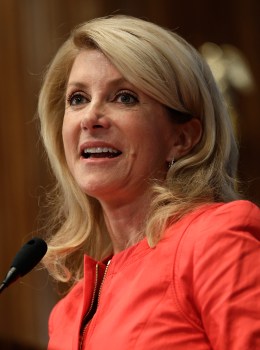
Wendy Davis at the National Press Club on August 5, 2013.
In the weeks since she grabbed the national spotlight by filibustering an abortion bill in Texas, state Sen. Wendy Davis has been bouncing around Washington D.C. in what feels like a showcase for the Democratic Party’s newest star. The question has been just what she was planning to do with all the attention.
So far Davis has hosted two fundraisers in D.C., a $500 breakfast at Johnny’s Half Shell near the Capitol, followed by a happy hour event with tickets ranging between $25 to $250 at U Street bar Local 16. At each event, Davis hinted at the possibility of running for governor in 2014, although she has neither confirmed nor denied if she will actually throw her famous pink sneakers into the race.
On Monday, Davis kept the public guessing. She addressed a crowd during a luncheon at the National Press Club and her response to the question on her gubernatorial bid was no different. “I can say with absolute certainly that I will be running for one of two offices, either my state senate seat or the governor,” Davis said during a question and answer session.
That decision, she said, will be coming in a matter of weeks. If she runs for governor, she will face an uphill climb against the Republican Texas Attorney General Greg Abbott, who announced his bid on July 14. In the meantime, however, Davis is happy to bask all the national attention she can muster, repeating the sort of broadly appealing bromides that politicians seeking higher office often embrace. “Texans — and women all over the country — deserve leaders that care, that listen and that work to protect their interests,” Davis wrote in a mid-July Op-Ed for the Washington Post. At the fundraising event at Local 16 on July 25 Davis told the crowd, “Texans deserve leaders who offer more than partisanship, more than extremism.”
At Monday’s event Davis reiterated that sentiment. “For all the rhetoric—and I know we all hear it about big government or small government—Texans want what I think everyone wants,” Davis said during her prepared remarks. “They just want to see good government.”
She cast herself as a post-partisan leader, saying her constituents in District 10, “never want to talk about party affiliation; they want to talk about problems.” While serving on both the local and state levels Davis said she got used to “working in areas that aren’t considered naturals for Democrats,” including shale gas drilling and transportation planning, yet continuing the fight for more Democratic principles including education funding and consumer reform.
“What we see in Texas we see all over the country where districts have been drawn through redistricting that have meant conversations now only take place at the extreme party level,” said Davis. “It’s not reflective of who people in Texas really are.”
In Texas, however, Davis and the Democratic party still have far to go. In early July, 39% of voters had a favorable opinion of Davis, compared to 29% who viewed her unfavorably and 32% who had no opinion of her, according to a Public Policy Polling report. Davis trailed Attorney General Abbott by 8 points when voters were asked who they would choose in a governor’s race between the two.
Texans also, by in large, supported the abortion restriction she tried to block with the filibuster that thrust her into national the spotlight. According to a June University of Texas and Texas Tribune poll, 62% of respondents supported the 20-week ban on abortions that was included in the bill. In general, 36% of Texans polled believe abortion should always be legal compared to 16% who say it should never be permitted. The abortion bill also required abortion clinics to meet the standards of ambulatory surgical centers and requires abortionists to have admitting privileges at local hospitals. After the Davis filibuster, the bill passed the state Senate and Gov. Rick Perry signed it into law on July 18.
Some Democrats are nonetheless hoping that Davis will play a central role in changing attitudes in the state. Texas State Senator Rodney Ellis says the only way to know whether or not Texas is likely to tread away from being a red state and more toward being purple is for her to run. “All of the ingredients are there for Texas to be at least a purple state,” Ellis told TIME. The demographic breakdown of Texas, according to the Census, is nearly identical to that of the U.S. as a whole, he said. “The best way to test it for [a Democrat] to run and to run at the top of the ticket.”
Regardless of whether or not her historic filibuster leads to a higher position in government, Davis said she’s glad she was able to be a “voice for people.” “If any outcome for me comes from the moment in the spotlight that the filibuster provided it would be to make sure that I play a part in changing that in Texas,” she told the national press.

